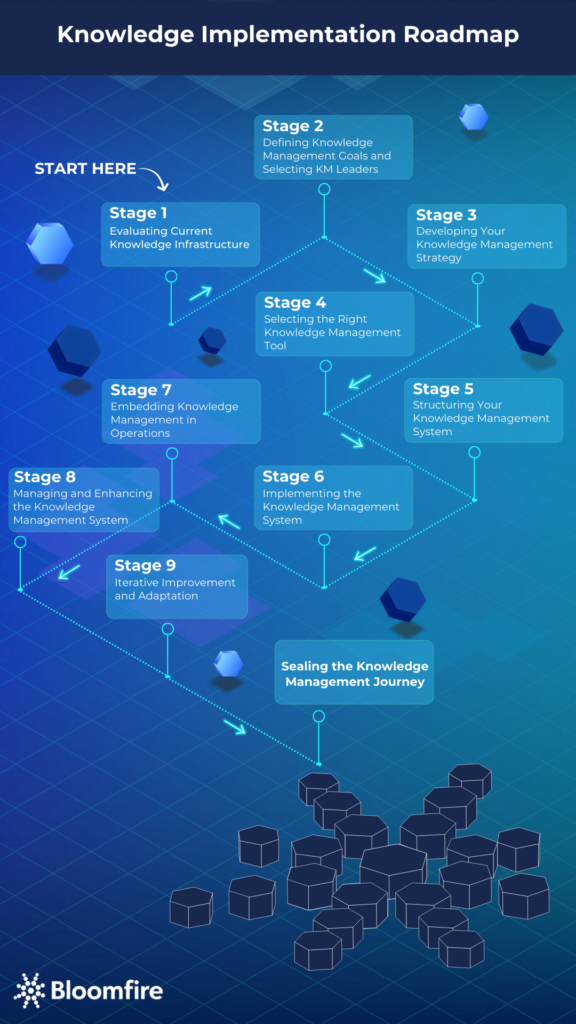

Betsy leads the customer success and implementation teams at Bloomfire. Passionate about the people side of knowledge engagement and knowledge sharing, Betsy shares real-world experience with the challenges faced by companies with a knowledge management problem.

Navigating the intricate world of knowledge management is more than a strategic initiative; it’s about connecting people with the information they need at the right time. As someone who’s helped launch successful knowledge management programs for various organizations, I’ve seen firsthand how the right approach can transform business processes. It’s not just about managing information; it’s about fostering a culture where knowledge sharing becomes second nature.
In this guide, we’re going deep into the knowledge management process. We’ll explore the essential steps and strategies that make up an achievable knowledge management roadmap, all through the lens of practical, real-world application. You’ll get an inside look at how knowledge management can streamline your business processes, with Bloomfire playing a central role in this transformation. Think of this guide as your blueprint to understand the theoretical aspects of knowledge management and see how these concepts and essential stages of knowledge management come to life, driving efficiency and innovation in your organization.
The journey to effective knowledge management begins with a solid foundation. This critical first step involves a comprehensive assessment of your organization’s current state of knowledge – understanding what information you have, where it resides, and how it is accessed and used. A crucial part of this process is identifying your business’ specific knowledge needs and the gaps in your current knowledge management system. It’s about pinpointing where your knowledge assets fall short and creating a plan to bridge these gaps.
To gain a holistic view, you should involve various organizational stakeholders in this initial phase. This collaborative approach ensures that your knowledge management strategy is inclusive and aligns with your organization’s diverse needs and functions. Whether streamlining decision-making, enhancing employee collaboration, or improving customer service, understanding these goals is paramount. With this insight, you can begin to chart a course for a knowledge management process that addresses your immediate needs and positions your organization for future growth and adaptability, leveraging tools like Bloomfire to transform these plans into actionable strategies.
Transitioning from laying a solid foundation is the next crucial step in any knowledge management implementation roadmap, focusing on understanding what knowledge is vital for your employees and how it impacts your business. It involves scrutinizing existing processes, employee feedback, and customer interactions to identify knowledge gaps that hinder performance or growth.
Tools like Bloomfire illuminate these gaps by providing insights into how employees search for and engage with information. By analyzing patterns in organizational knowledge usage, you can uncover areas where additional resources or improved accessibility can make a significant difference. This targeted approach ensures that your knowledge management initiatives are comprehensive and acutely tailored to meet your business’s and its stakeholders’ unique demands.
Embarking on the knowledge management journey involves several key stages. Each stage represents a critical step in building a robust and effective knowledge management process. This involves implementing tools and creating a holistic approach that aligns with your organization’s objectives and culture. In the following sections, we’ll break down these stages, offering insights into how each contributes to the overall success of your knowledge management roadmap efforts.

The first stage in optimizing your knowledge management process is thoroughly evaluating your existing knowledge infrastructure. This foundational step is critical to setting the stage for a successful knowledge management strategy. It includes:
This will set the groundwork for a robust knowledge management strategy, ensuring that subsequent actions are built on a clear understanding of your current knowledge ecosystem.
Transitioning from the evaluation phase, Stage 2 revolves around defining clear, actionable knowledge management goals and selecting the right leaders and stakeholders for your KM initiative. It involves:
By defining precise and measurable knowledge management goals and selecting a dedicated team to lead these efforts, you create a focused direction for all subsequent KM activities and establish a solid foundation for your knowledge management strategy.
In Stage 3, the focus shifts to developing a comprehensive knowledge management strategy. Essential elements of this stage include:
A well-developed knowledge management strategy is crucial for the successful integration and effectiveness of knowledge management in your organization.
A critical part of your strategy is choosing the right tools and building a framework that supports your knowledge management goals. This involves selecting platforms that align with your specific needs – whether it’s about deep-indexing content, facilitating collaboration, or providing intuitive search capabilities. The right tools will enhance efficiency and ensure that knowledge flows smoothly across your organization.
Selecting the right tool is a pivotal knowledge management process step. This decision is crucial and should be based on thoroughly evaluating various software tools’ features, scalability, and compatibility with your existing systems. The ideal technology will empower your team, foster knowledge sharing, and adapt to your evolving business needs.
Here’s a list of key qualifications and questions to consider when evaluating potential tools:
Evaluating these factors will help you select a knowledge management platform that fits your current needs and supports your long-term knowledge management goals.
Structuring your system effectively is one of the critical steps in knowledge management. This stage focuses on organizing and categorizing knowledge, aligning with best business process knowledge management practices. Key steps include:
This stage is about creating a system that stores knowledge and makes it a living, breathing part of your organizational ecosystem, facilitating easy access and encouraging active use.
Stage 6 is where your knowledge management process examples come to life. Implementation involves rolling out the chosen system across your organization. This stage includes:
This step ensures the system is operational and aligns with user expectations and business goals. It also aligns employees with the organizational knowledge management goals. It ensures they have the skills and understanding of the new knowledge management system, creating better long-term outcomes.
With the knowledge management system in place, the next step is integrating it into your organization’s daily operations. This involves:
This integration ensures that knowledge management becomes an integral part of the workflow rather than an isolated function. The effectiveness of such integration is echoed in the experience of Dexcom.
“Bloomfire has helped us democratize research across the company, and we’ve received positive feedback from colleagues. Knowledge sharing is at an all-time high.”
Dexcom Associate Marketing Research Manager
Stage 7 focuses on deeply embedding knowledge management into the fabric of your organizational operations. This means:
While embedding KM into operations, organizations often encounter challenges such as securing employee and leadership buy-in, managing technology fatigue, handling information overload, documenting knowledge effectively, and ensuring content trustworthiness. Navigating these challenges is crucial for KM to become a natural and essential part of the organizational ecosystem, continually driving value and improvement.
This stage involves the ongoing management and enhancement of the system, which is crucial in the knowledge management process for maintaining the system’s relevance and effectiveness. This includes:
Effectively managing these aspects is crucial to ensure your knowledge management system remains a dynamic and valuable resource. It is essential to remember that a knowledge management system is only as good as the knowledge it contains – so adapting to changing organizational needs and ensuring that the content is regularly updated and relevant is critical to maintaining its effectiveness and value.
An essential part of managing your knowledge management system involves monitoring its usage and efficacy, evaluating its impact on business outcomes, and adapting based on the insights gathered. Regularly tracking performance helps identify how effectively the system is being utilized. Concurrently, actively seeking user feedback can uncover areas needing improvement or enhancement. Adaptability in making changes ensures that the knowledge management system evolves to meet your organization’s and its users’ dynamic needs.In addition to these practices, defining and monitoring key performance indicators (KPIs) and metrics that align with your organization’s goals is crucial. A sound KM system should include built-in analytics features, enabling you to track engagement and measure the impact of knowledge management on business outcomes. Effective analytics tools provide insights into user behavior, content effectiveness, and areas for improvement, guiding strategic decisions and continual refinement of KM practices.
Iterative improvement and adaptation, the critical and final stage in the knowledge management roadmap, focuses on continuously evolving and refining the system to meet changing organizational demands. This means:
This final stage ensures that your knowledge management system remains relevant and effective, adapting to the evolving needs of your organization.
As we conclude our exploration of the knowledge management process, remember that this journey doesn’t have a definitive end. It’s a continuous improvement and adaptation cycle, evolving alongside your organization. The stages we’ve discussed serve as a knowledge management implementation roadmap, but the real power lies in the iterative process—learning, adapting, and growing. Embrace this dynamic nature, and you’ll find that your knowledge management system becomes an invaluable asset, propelling your organization toward sustained success and innovation.
Ready to transform how your organization handles knowledge? Talk with a KM expert.
About the Author
Betsy leads the customer success and implementation teams at Bloomfire. Passionate about the people side of knowledge engagement and knowledge sharing, Betsy shares real-world experience with the challenges faced by companies with a knowledge management problem.




See how Bloomfire helps companies find information, create insights, and maximize value of their most important knowledge.

See Bloomfire in action across several potential configurations. Imagine the potential of your team when they stop searching and start finding critical knowledge.
Also of InterestWe are experts in knowledge management software. We help companies enable their employees to work more efficiently, align teams, and achieve better results.
Unlock Knowledge PowerExperience the power of knowledge. Request a demo to get started with Bloomfire.